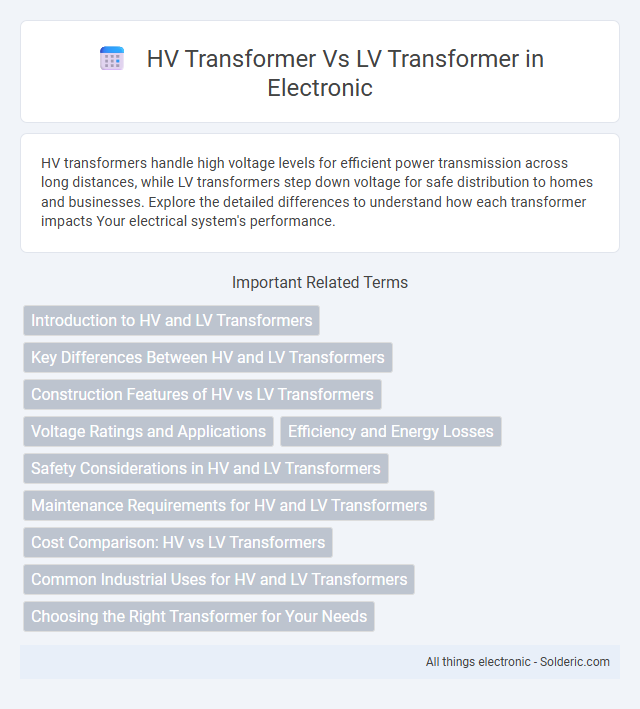HV transformers handle high voltage levels for efficient power transmission across long distances, while LV transformers step down voltage for safe distribution to homes and businesses. Explore the detailed differences to understand how each transformer impacts Your electrical system's performance.
Comparison Table
| Feature | HV Transformer (High Voltage) | LV Transformer (Low Voltage) |
|---|---|---|
| Voltage Range | Above 33kV | Below 1kV to 33kV |
| Primary Use | Power transmission over long distances | Power distribution and final voltage step-down |
| Size & Weight | Larger and heavier | Smaller, compact design |
| Insulation | High-grade insulation materials | Standard insulation suitable for lower voltages |
| Efficiency | High efficiency for long-distance transmission | High efficiency for local distribution |
| Cooling Methods | Oil-immersed or air-cooled | Typically air-cooled or dry type |
| Cost | Higher cost due to materials and complexity | Lower cost, simpler design |
| Applications | Power plants, substations, transmission networks | Residential, commercial, industrial power distribution |
Introduction to HV and LV Transformers
HV transformers operate at high voltages typically above 35 kV, playing a crucial role in power transmission by stepping up voltages for efficient long-distance electricity transport. LV transformers function at voltages below 1 kV, primarily used for distributing electricity safely to residential and commercial consumers. Both transformer types are essential for maintaining voltage levels suitable for different stages of electrical power delivery systems.
Key Differences Between HV and LV Transformers
HV transformers operate at high voltages typically above 33 kV, designed for efficient long-distance power transmission, while LV transformers function at voltages below 1 kV, primarily for local power distribution and consumer use. The insulation requirements in HV transformers are significantly higher due to increased electrical stress, leading to larger core sizes and complex cooling systems compared to compact and simpler LV transformers. HV transformers usually have lower current ratings but higher voltage ratings, whereas LV transformers handle higher currents at lower voltages, affecting their winding designs and overall efficiency.
Construction Features of HV vs LV Transformers
HV transformers are constructed with thicker insulation, larger core laminations, and spaced windings to handle high voltage stress and minimize corona discharge, whereas LV transformers use thinner insulation and compact windings due to lower voltage requirements. The HV transformer windings are often segmented and carefully layered to control electric field distribution, while LV transformers have simpler coil arrangements with fewer layers. Your choice between HV and LV transformers should consider these distinct construction features to ensure optimal performance and durability under specific voltage conditions.
Voltage Ratings and Applications
HV transformers operate at voltage ratings typically above 33 kV and are essential in power transmission for stepping down high voltages from power plants to lower levels, minimizing energy loss over long distances. LV transformers, functioning below 1 kV, are commonly used in distribution networks to supply safe, usable voltage to residential, commercial, and industrial equipment. The choice between HV and LV transformers depends primarily on system voltage requirements and the specific application's need for voltage regulation and safety.
Efficiency and Energy Losses
HV transformers typically exhibit higher efficiency than LV transformers due to reduced copper losses, as their windings carry lower currents relative to voltage levels. Energy losses in HV transformers are minimized because of better insulation and cooling methods, which help maintain optimal operating temperatures and reduce core losses. When selecting a transformer for your application, prioritizing HV transformers can lead to significant energy savings and improved overall efficiency in power transmission.
Safety Considerations in HV and LV Transformers
High voltage (HV) transformers require stringent insulation and protective measures to prevent electrical hazards such as arc flash and dielectric breakdown, ensuring operational safety in industrial and utility settings. Low voltage (LV) transformers, while posing lower shock risks, demand proper grounding and overload protection to avoid equipment damage and maintain user safety in residential and commercial applications. Understanding the distinct safety protocols for your HV and LV transformers is crucial to minimizing electrical risks and ensuring compliance with industry standards.
Maintenance Requirements for HV and LV Transformers
HV transformers require regular inspection of insulation resistance, bushings, and cooling systems to prevent failures and ensure operational reliability, often involving specialized equipment due to high voltage levels. LV transformers maintenance focuses more on cleaning, tightening connections, and thermal checks, with simpler diagnostic tools compared to HV counterparts. Adhering to manufacturer-recommended schedules and employing predictive maintenance techniques significantly reduces downtime and extends the lifespan of both HV and LV transformers.
Cost Comparison: HV vs LV Transformers
HV transformers generally come with higher upfront costs compared to LV transformers due to their complex design and insulation requirements for handling high voltage levels. Maintenance expenses for HV transformers can also be greater because of the specialized equipment and expertise needed for servicing. Your choice between HV and LV transformers should balance initial investment against long-term operational efficiency and application-specific demands.
Common Industrial Uses for HV and LV Transformers
HV transformers are primarily used in power transmission systems to step up voltage levels for efficient long-distance electricity transport, reducing energy loss and improving grid stability. LV transformers are commonly found in industrial facilities to step down voltage to safer, usable levels for machinery, lighting, and control systems, ensuring equipment protection and operational efficiency. Both transformer types are essential in manufacturing plants, refineries, and large commercial complexes to optimize power distribution and maintain consistent electrical performance.
Choosing the Right Transformer for Your Needs
Selecting between HV transformers and LV transformers depends primarily on voltage requirements and application scope; HV transformers handle high voltages above 35kV, ideal for power transmission and industrial use, while LV transformers operate below 1kV, suited for residential and commercial electrical distribution. Your choice should consider efficiency, insulation levels, and safety standards to ensure optimal performance and reliability. Evaluating load capacity, site conditions, and budget will guide you to the right transformer for your specific electrical needs.
HV transformer vs LV transformer Infographic

 solderic.com
solderic.com